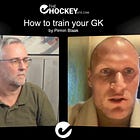Involve Your Goalies
Some principles to ensure team training is also beneficial for your goalkeeper
Goalkeepers are often overlooked in team training, but incorporating them effectively is crucial for their development and the overall team dynamic. Both Mili Arrotea (ARG🇦🇷 & AUS🇦🇺) and Pirmin Blaak (NED🇳🇱) have shared valuable insights on this topic during their masterclasses, and Andreu Enrich (ESP 🇪🇸) has also touched on the importance of involving goalkeepers in small-sided games. Here are some principles to ensure team training is also beneficial for your goalkeeper…
Involve Goalkeepers in Tactical Drills
Goalkeepers should be part of tactical drills, especially those involving defensive structures and set pieces. Mili Arrotea emphasized that goalkeepers play a key role in organizing the defense and communicating with outfield players. Their positioning and input can significantly impact the effectiveness of team tactics.
For example, during penalty corner defense drills, ensure the goalkeeper is actively involved in positioning defenders and communicating about marking responsibilities. This not only helps the team but also sharpens the goalkeeper’s organizational skills.
Design Small-Sided Games with Goalkeepers in Mind
Andreu Enrich highlighted that small-sided games (SSGs) are often more engaging and beneficial for goalkeepers than isolated drills. However, it’s essential to tailor these games to ensure goalkeepers are actively involved.
If the SSG doesn’t naturally involve much action for the goalkeeper (e.g., an 8v8 game with a focus on midfield play), give them an additional focus, such as organizing the defense or practicing distribution under pressure. This keeps them engaged and ensures they’re developing relevant skills.
Train Decision-Making Under Pressure
Pirmin Blaak stressed the importance of simulating game-like scenarios where goalkeepers must make quick decisions under pressure. This can be integrated into team training by designing drills that replicate real match situations.
For example, set up a 3v2 counterattack drill where the goalkeeper must decide whether to stay on the line or come out to challenge the attackers. Vary the scenarios to train different decision-making processes.
Incorporate Reaction and Recovery Training
Goalkeepers need to be sharp in reacting to shots and recovering quickly for follow-up saves. Blaak suggested using tools like rebound nets or tennis balls to train reaction speed, but these principles can also be applied in team settings.
During shooting drills, for example, encourage attackers to aim for rebounds or deflections. This forces the goalkeeper to react quickly and recover their position, mimicking the chaos of a real game.
Encourage Communication and Leadership
Goalkeepers have a unique perspective on the field and should be encouraged to communicate effectively with their teammates. This is especially important in defensive drills and game scenarios.
Key Tip: During team training, emphasize the goalkeeper’s role in directing the defense. For example, they should call out marking assignments, warn about unmarked players, and guide the defensive line’s positioning.
Provide Specific Feedback
Both Arrotea and Blaak emphasized the importance of tailored feedback for goalkeepers. While team training often focuses on outfield players, take the time to observe and provide constructive feedback to the goalkeeper as well.
Use video from your training to review the goalkeeper’s positioning, decision-making, and communication during team drills. Highlight both strengths and areas for improvement.
Balance Team and Individual Focus
While goalkeepers should be integrated into team training, they also need time to work on individual skills. Blaak recommended a mix of team-based and individual training to ensure goalkeepers develop both their technical and tactical abilities. Make sure they have time for both.
Start the session with individual goalkeeper drills (e.g., footwork, diving, or shot-stopping), then transition into team training where they can apply these skills in a tactical context.
Create Competitive Scenarios
Goalkeepers thrive in competitive environments where they can test their skills against outfield players. Blaak suggested incorporating shootout competitions or scoring challenges into training to keep goalkeepers motivated and engaged.
End the session with a 5v5 game where the goalkeeper earns points for saves, and attackers earn points for goals. This adds an element of fun and competition while reinforcing key skills.
Final Thoughts
Integrating goalkeepers into team training requires thoughtful planning and a focus on their unique role. By involving them in tactical drills, designing engaging small-sided games, and providing specific feedback, you can ensure that team training is as beneficial for your goalkeeper as it is for outfield players.
If you're looking for an answer to your own coaching questions, ask your question here to get an answer based upon the many, many talks I had with some of the best coaching minds in the game of hockey 🏑
And if you’d like tailored advice for your team, you can always book a session with a top coach via https://gotyourback.app
Sources:
3x Mili Arrotea from Argentina, coaching in Australia
Pirmin Blaak, the Dutch GK who was instrumental in winning gold in Paris
Andreu Enrich from Spain and coaching in Germany about SSG










